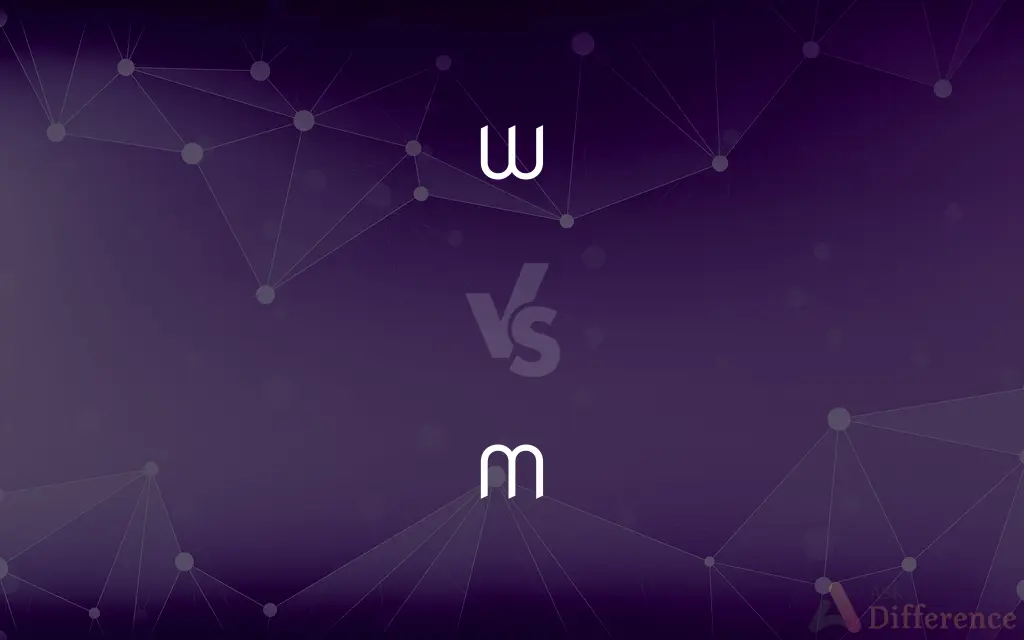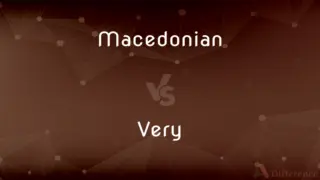W vs. M — What's the Difference?
By Fiza Rafique & Maham Liaqat — Updated on March 17, 2024
W is a letter that creates a 'double u' sound, often used in words like "water," while M produces a nasal 'm' sound, as in "moon."

Difference Between W and M
Table of Contents
ADVERTISEMENT
Key Differences
W, representing a 'double u' sound, is a versatile letter used in various English words, such as "water," "willow," and "winter." It often signifies a soft, flowing sound, reminiscent of its visual representation which suggests waves or motion. On the other hand, M, with its nasal 'm' sound found in words like "moon," "moment," and "memory," conveys a sense of solidity and depth. The visual shape of M, with its peaks and valleys, can be associated with mountains or mounds, symbolizing stability.
In terms of phonetic classification, W is considered a semi-vowel or glide, where the shape of the vocal tract changes from that of a consonant to that of a vowel, making its sound more fluid and less obstructed. Whereas M is categorized as a bilabial nasal consonant, involving both lips and allowing air to pass through the nose, which gives it a resonant quality.
The usage of W and M also varies in word formation; W often appears at the beginning of words or syllables, contributing to the word's initial sound and influencing its tone. M, however, can comfortably sit at the beginning, middle, or end of words, offering a versatile role in word structure and contributing to the rhythm and meter of speech.
In typography, W and M are notable for their width and occupy more horizontal space in text compared to most other letters. This characteristic can impact text layout and design, where W's spread-out appearance and M's three-point peak can create visual balance or tension, depending on their placement.
Despite their visual similarities, with both letters consisting of peaks and valleys, W and M serve different roles in language and sound production. Their distinct sounds and applications highlight the rich variety and flexibility of the English alphabet, demonstrating how each letter contributes uniquely to the tapestry of language.
ADVERTISEMENT
Comparison Chart
Sound
'Double u' sound
Nasal 'm' sound
Phonetic Type
Semi-vowel or glide
Bilabial nasal consonant
Position in Words
Often at the beginning
Can be at beginning, middle, or end
Typography
Wide, takes up horizontal space
Wide, with a three-point peak
Symbolism
Suggests waves or motion
Symbolizes stability, like mountains
Compare with Definitions
W
Commonly used at the beginning.
Wendy went westward.
M
Creates a nasal 'm' sound.
Molly made more muffins.
W
Often associated with waves or motion.
The logo's W mimics the waves.
M
Features a three-point peak.
The letter M stands tall in 'Mountain.'
W
Produces a 'double u' sound.
Watch the waves wobble.
M
Reflects stability, akin to mountains.
M in the logo symbolizes strength.
W
Notably wide, affecting text layout.
The word 'www' widens the webpage.
M
Versatile in placement.
Amber's moment of mirth.
W
Considered a semi-vowel.
In phonetics, W transitions from a consonant to a vowel sound.
M
A bilabial nasal consonant.
M's sound is produced by both lips.
W
W, or w, is the twenty-third and fourth-to-last letter of the modern English and ISO basic Latin alphabets. It usually represents a consonant, but in some languages it represents a vowel.
M
M, or m, is the thirteenth letter of the modern English alphabet and the ISO basic Latin alphabet. Its name in English is em (pronounced ), plural ems.
W
The 23rd letter of the modern English alphabet.
M
The 13th letter of the modern English alphabet.
W
Any of the speech sounds represented by the letter w.
M
Any of the speech sounds represented by the letter m.
W
The 23rd in a series.
M
The 13th in a series.
W
Something shaped like the letter W.
M
Something shaped like the letter M.
W
Watt
M
(grammar) masculine
W
West
M
Abbreviation of meter
W
Witness
M
Abbreviation of mile
W
Work
M
Abbreviation of month
W
Abbreviation of win
M
Abbreviation of minute
W
(cricket) wide
M
Abbreviation of million
W
White
M
Abbreviation of minim
W
Abbreviation of with
M
(music) measure
W
With a wing (on the Enneagram)
When Sharon took the Enneagram test, she came out as a 3w2.
M
(obsolete) thousand
W
The twenty-third letter of the English alphabet, is usually a consonant, but sometimes it is a vowel, forming the second element of certain diphthongs, as in few, how. It takes its written form and its name from the repetition of a V, this being the original form of the Roman capital letter which we call U. Etymologically it is most related to v and u. See V, and U. Some of the uneducated classes in England, especially in London, confuse w and v, substituting the one for the other, as weal for veal, and veal for weal; wine for vine, and vine for wine, etc. See Guide to Pronunciation, 266-268.
M
(knitting) make
W
A heavy gray-white metallic element; the pure form is used mainly in electrical applications; it is found in several ores including wolframite and scheelite
M
M, the thirteenth letter of the English alphabet, is a vocal consonant, and from the manner of its formation, is called the labio-nasal consonant. See Guide to Pronunciation, 178-180, 242.
W
The cardinal compass point that is a 270 degrees
M
As a numeral, M stands for one thousand, both in English and Latin.
W
A unit of power equal to 1 joule per second; the power dissipated by a current of 1 ampere flowing across a resistance of 1 ohm
M
A quadrat, the face or top of which is a perfect square; also, the size of such a square in any given size of type, used as the unit of measurement for that type: 500 m's of pica would be a piece of matter whose length and breadth in pica m's multiplied together produce that number.
W
The 23rd letter of the Roman alphabet
M
A brand or stigma, having the shape of an M, formerly impressed on one convicted of manslaughter and admitted to the benefit of clergy.
M
The basic unit of length adopted under the Systeme International d'Unites (approximately 1.094 yards)
M
Concentration measured by the number of moles of solute per liter of solvent
M
The cardinal number that is the product of 10 and 100
M
The 13th letter of the Roman alphabet
M
Denoting a quantity consisting of 1,000 items or units
Common Curiosities
Why do W and M look similar in shape?
Their shapes, with peaks and valleys, are a result of typographic design but represent different sounds.
Is it common for W to start words, and where does M typically appear?
W often starts words, while M can appear at the beginning, middle, or end.
How do W and M contribute to the rhythm of speech?
W's fluid sound and M's resonant quality each add unique rhythm and meter to speech.
In typography, how do W and M impact text layout?
Their width requires more horizontal space, influencing layout and design.
What is the main sound difference between W and M?
W creates a 'double u' sound, while M produces a nasal 'm' sound.
Are W and M vowels or consonants?
W is considered a semi-vowel or glide, and M is a consonant.
Can W and M be used interchangeably in words?
No, due to their distinct sounds and roles in word formation.
Is W always pronounced the same in all words?
Generally, yes, but pronunciation can vary slightly with accents and dialects.
Do W and M have any symbolic meanings in design?
W can suggest waves or motion, while M symbolizes stability like mountains.
What phonetic category does W fall into?
W is categorized as a semi-vowel or glide.
What does the M sound involve in its production?
M's sound involves both lips and nasal passage, making it a bilabial nasal consonant.
Can the typography of W and M affect readability?
Yes, due to their width, the layout and spacing of text containing W and M can impact readability.
Can M appear at the end of English words?
Yes, M can comfortably sit at the end of words.
What role does M play in word structure?
M is versatile, contributing to a word's structure whether at the beginning, middle, or end.
How does the sound of W influence the tone of a word?
W's soft, flowing sound often lends a gentle or whimsical tone to words.
Share Your Discovery

Previous Comparison
Sausage vs. Jerky
Next Comparison
Macedonian vs. VeryAuthor Spotlight
Written by
Fiza RafiqueFiza Rafique is a skilled content writer at AskDifference.com, where she meticulously refines and enhances written pieces. Drawing from her vast editorial expertise, Fiza ensures clarity, accuracy, and precision in every article. Passionate about language, she continually seeks to elevate the quality of content for readers worldwide.
Co-written by
Maham Liaqat













































